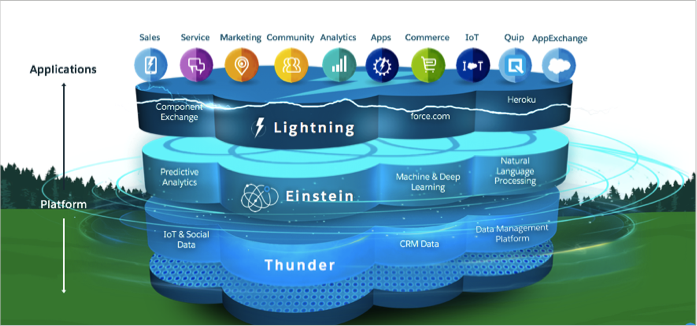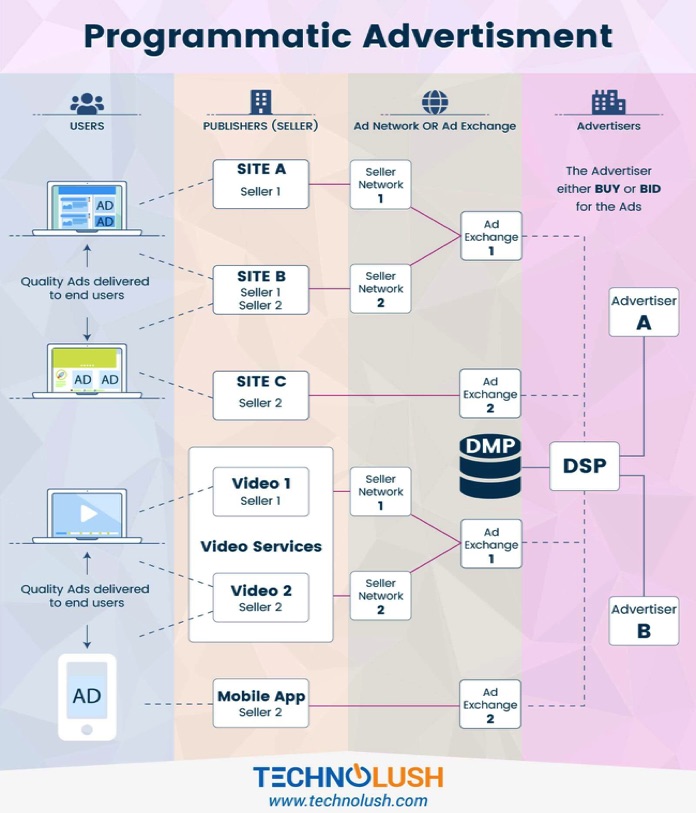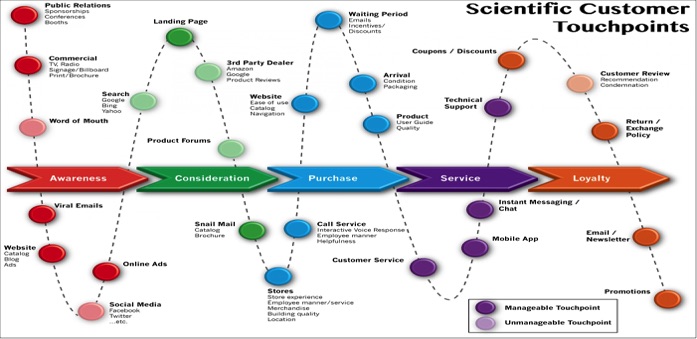3 Martech Applications
Firms need only to master a handful of applications. With proper training, these applications can be easily mastered by your employees, except for
data analytics where you will need to hire. In the thousands, they cover
the entire Sales and Marketing Function:
4 The Integrated Offerings
The best tools are those put together by a partnership between 2 or more companies to pool their respective products, as with Salesforce in sales (CRM) and Google in Marketing (Google Marketing Platform), even if
both claim to have the other's products:
1.4 MARKETING CHANNELS - THE CUSTOMER JOURNEY. As the table below shows, ad tracking tools enable businesses to follow practically every move their customers make online along the entire sales cycle or customer journey:
1.5 MARKET RESEARCH - DATA ANALYTICS. Data analytics tools can now collect primary and secondary data on almost every move billions of users make on the Internet from any mobile device. The biggest sources of information are the mega social media and eCommerce sites with billions of users, such as Facebook and Amazon. But just about anybody can subscribe to the myriad of app tracking tools to collect such data, not only on visitors to one's website but also on these mega sites. This can be run in a few seconds and then aggregated and visualized using such easy-to-use business intelligence and data visualization tools as Microsoft's Power BI or Salesforce's Tableau. Moreover, data can be captured in all formats
Needless to say, the combination of user data and online ads has become a multi-billion dollar business. It is both Facebook's (ad sales $98B) and Google's (ad sales $209B) primary source of revenue for 2021
1.6 COMMUNICATION CHANNELS - THE BACKLINK. This is where the customer's journey is ultimately supposed to end, after all of the above mentioned communications tools have been used (advocacy/retention/attribution, programmatic advertising, data analytics): to get him to your website. Surprising as this may sound, the Internet works by....word-of-mouth, expressed by a hyperlink to your website, which users, liking your product, would share and recommend on a social media site. The more your website's link is referred to on the most visited sites, the more visits you'll receive on your own website. Only at the very end will visitors, your potential customers, google you for more information.
To get sales leads, the Internet's MO is as follows:
Content. Make a great product at the right price, provide
seamless service, and have great content on your website
Multichannel. Connect, cold call and communicate at the right
place, through those channels where your target customers spend
most of their time,ensure that those users who like your product
will promote you by posting your link to friends to visit you
Clicks It is the number of clicks on your strategically-placed
links which will bring you the high number of hits on Google
you crave for, not the other way around
* in Google's search algorithm, your website link is called a
"backlink" in that users click to link back to your website
2 The Red Line - User Privacy
Users are beginning to push back on what they feel is a violation of their privacy. Businesses have begun to adapt their offering accordingly. For example, Apple users can now limit this abusive form of ad tracking on their mobile devices, stopping on its tracks any form of ad tracking whatsoever when they go online (Facebook can track your every movement not only on its website but across all apps)
As a result, we may be witnessing a return to the type of marketing research we conducted back in the old days, where we would ask a sample of representative users to be followed on their customer journey, this time
on the Internet
1 Martech Fundamentals
1.1 COMMUNITIES. On a par with traditional media and online search and advertising, online user Communities present on Social Media and other eCommerce websites now carry enormous weight in shaping consumers' buying behavior. It is in this digital version of customer groups that customers find product reviews they can trust from their network of "friends, families, fans and followers" known as the F-factor
Community-Focused Marketing has become a new discipline of sorts, where the fundamental methods of market analysis, segmentation, positioning, and differentiation have been refreshed, by adding new digital tools, such as Data Analytics, to gain insights on the behavior of billions of members spread out across these online communities, individually and instantaneously
1.2 INFLUENCER MARKETING. Businesses now widely use 3 tools to try to generate sales leads, attract, acquire and retain customers within these communities. These 3 tools are Advocacy, Referral, and Attribution. They form what is now called Influencer Marketing
(see villagemarketing.com and Amazon's Influencer program)
1.3 SEARCH AND PROGRAMMATIC ADVERTISING. The most noteworthy innovation in online advertising has been in the area of Programmatic Advertising. While the other major ad formats (Search, Video, Banner, and Social Media) give no other choice to advertisers than to go through one website in a many-to-one relationship, Programmatic Advertsing allows them to bypass it through an ad exchange marketplace, in a many-to-many relationship between ad publishers and advertisers. Ad agencies, big and small, now offer an integrated suite of services combining content ("creative"), data and programmatic campaigning across all channels (see here the houses that Martin Sorrell built, WPP and S4 Capital )
However, all online advertising today is "programmatic", whether it is placed indirectly through Google's Search website or directly on all
websites in general. As briefly explained, both Search and Programmatic Advertising run on the same software, the Ad Server, which allows businesses to shop for ad space and place their ads anywhere in a fraction of a second (less than 200 milliseconds), at the very moment a visitor is viewing a page on the website. Because the probability that a viewer would click on the ad is so low - 2% of clicks to page views is good but rare - hundreds of ads must be served every day. A typical visitor on the most popular sites is served about 150 to 200 ads daily. Multiplied by the number of Internet users, this can easily translate into hundreds of billions of ads being served to millions of websites. To process such a volume of ads and ad space, advertisers and publishers must pre-program ahead for each ad campaign and ad offering, hence the term "programmatic" being used
How Programmatic Advertising Works. Programmatic Ad Exchanges are organized as auctions with advertisers acting as bidders of ad space and publishers acting as providers of ad space on their websites. Intermediary firms have sprung up to offer their services to both parties to the transaction:
Demand-Side Platforms (DSPs) which allow advertisers to buy
publishers' ad space (inventory) available on multiple ad
exchanges in real time
Supply-Side Platforms (SSPs) which enable publishers to
sell their ad space, filling them with ads and receiving revenue
in real time
The transaction is automated and happens in milliseconds. Preparation is therefore key for the advertiser who must provide beforehand to his buyer, the DSP, his budget limits and targeting parameters. Below is a step-by-step description of the transaction process:


MARKETING ANALYTICS
Business Intelligence
Data Visualization
Device Integration
Mobile & Web Analytics
MARKETING OPERATIONS
Budgeting & Finance
Workflow (process)
Agile Operations Management
Collaboration (team)
Talent Management
Audience/Marketing Data
Customer Data Platform
Data Management Platform
Marketing Analytics
Advertising & Promotion:
Display & Programmatic Advertising
Native and Content Advertising
Search and Social Advertising
Video Advertising
Public Relations
Social & Relationships:
Advocacy, Loyalty, Referrals
Call Analytics
Community & Reviews
Conversational & Chat
Customer Engagement
Events, Meetings & Webinars
Social Media Marketing
PRICE
Pricing Intelligence
Market-based Pricing
AI Competitor Pricing
Dynamic Pricing
Price Optimization
Profitability & Growth Pricing
PLACE
Multi-Channel Marketing
Ecommerce Marketing
Ecommerce Platform
Retail Marketing
Sales Automation, Enablement
Affiliate Marketing
PRODUCT
Content Marketing
Email marketing
Interactive Content
Sales Lead
Mobile Apps
Personalization
SEO
Video Marketing
Experience Design
PROMOTION
MARKETING STRATEGy (the 4 Ps)
2. LEADS
Lead Engagement (bots,..)
Appointment Scheduling
Video Meetings & Selling
Presentation & Demos Creation
Conversation Optimizaiton
Prospect Gifting
Messaging (emails,..)
1. CONTACTS
Web Visitor ID
Web Targeting & Purchase Intent
Web Insights & Relationships
Social Media Capture
Mobile Capture
Web Capture
3. PROSPECTS
Customer's ROI & TCO
AI Guided Process
Digital Sales Rooms
Opportunity Conversion
SALES STRATEGY (Sales Cycle steps 1 to 6)
4. CUSTOMER ACQUISITION
Pipeline Reviews
Digital Signature (smart contracts)
Contract Proposals & RFPs
Configure, Price, Quote
Unified Customer View
5. SALES MANAGEMENT
Sales Compensation
Quota & Territory Assignment
Sales Forecasting & Reporting
Gamification
Pre-Sales Management
Salesforce Skills Development
6. CUSTOMER Retention
CRM Database
Unified Activity Entry
CRM System Modules
customers as
advertisers
We will dwell here more deeply into one of the 4 Metaverse platforms, the Marketing Technologies
or Martech Platform.
These technologies are in fact computer programs put into mobile app form, which users can click on to access the Web platform (see point 3 below "Martech applications")
Marketing Fundamentals
The F-Factor
Search Advertising ($170B)
Advertisers
& Their Ad Agencies
Publishers
Programmatic Advertising ($14B)
Advertisers
& Their Ad Agencies
Publishers
User Privacy
Customer JOurney
The Martech Decision
5 The Martech Decision
Once we've gained a basic understanding of HOW the few digital marketing tools work as described above, deciding on the WHERE, WHAT, AND WHO becomes quite simple:
Where - The User Apps (in fact the Website) The apps are the
digital marketing channels. The ad publisher sells ad space on his
website through his app, i.e., Google's Search and Facebook's
Social Media websites are apps anyone can download. Each app
has an interface, the Application Programming Interface (API),
which acts as a tollgate advertisers must pay for to place his ad.
They will choose the website with the audience profile which
matches their targeted user demographics and psychographics.
The latter is provided by the publisher with the help of Big Data
firms
What - The Ad Content Ad Agencies have adapted
their traditional line of work, namely Content Creation, Content
Personalization and Content Delivery to new digital formats.
In Content Creation, the new formats are video and mobile
marketing. The major innovation in Content Personalization is
its Interactive Content component. In Content Delivery,
Content Delivery Networks (CDN) are now able to deliver
seamlessly your digital ad anywhere to millions of websites in real
time, matching your targeted audience profile
Who - Communities The websites or apps of the FAANGs, telco
operators and eCommerce retailers now have their own community
section. For example, the Apple community in Reddit (of
Gamestop fame) has more than a million members
Table of Contents
1. Martech Fundamentals
. Communities
. Advocacy, Referral, Attribution
. Programmatic Advertising
. Customer Journey "Touchpoints"
. Data Analytics
. The Backlink
2. The Red Line - User Privacy
3. Martech Applications
4. The Integrated Offerings
5. The Martech Decision
Data Analytics
Who
Communities
What
Content
Where
Apps
HOW
Platform
buyers of ad space
suppliers of ad space
Platform
Data Management Platforms
(DMP)
Supply-Side Platforms
(SSP)
Ad Exchange Platforms
Demand-Side Platorms
(DSP)
Advertisers, with the help of Ad Agencies and Publishers connect to Ad Exchanges, including Google's own exchanges, to buy and sell ad space. Advertisers use Demand-Side Platforms (DSP) and Publishers use Supply-Side Platforms (SSP), directly or through service providers, to engage in an auction on Ad Exchanges (see table below). Ad Networks sell unsold ad inventory for publishers. They are not programmatic. 2 platforms, the Data Management Platform (DMP), providing the data tand the Ad Campaign Platforms run by Ad Agencies, provide campaign advisory and data analytics services
Major Digital Ad Formats or Technologies
Search Advertising 40% of Market
Google Ads, Google Search Results
Display Advertising 60% of Market
Banner Ads, Video Ads, Social Media Ads, Interstitial Ads,
Classifieds, Connected TV, Programmatic
Search Ad Servers
Programmatic Ad Servers
The Ad Server, used in both search advertising and programmatic advertising, represents the software backbone used to collect user information and to match it with the ad placed by the advertiser:
STEP 1: USER DATA COLLECTION
- his profile provided by his devices' unique IP Address, his mobile GPS location, and his demographic profile (date of birth is compulsory) when he registers as a member on Google, Facebook, Amazon,...
- his interests and shopping history provided by a log of all of his website visits
STEP 2: AD MATCHING
The ad is placed, matching the information collected on the user's profile and site visit information
Technically, the ad server is able to collect data on the website's page title, page content, on JS, CSS headings and meta tags. Keywords and their associations to the website's HTML fields are generated by the ad server's algorithms
Step 2. The F-Factor
Step 3. Customer as Business Partner
Step 4. Customer Acquisition
Promotion
Product
Place
Price
Friends
Families
Fans
Customer
Advocacy
Customer
Referral
Customer
Attribution
Step 1. The 4 Ps
customers as
salesmen
multi-channel
analytics
Customer
Engagement
Customer
Value
Proposition
New
Customers
Marketing
Mix
(what)
Communities
(who)
The Tools
(how)
The Sale
New
Leads
New Followers
Customer
Value Delivery


Influencer Marketing
The Google/Salesforce PArtnership
Martech
The Marketing Technologies
Note: all of these applications are nothing more than computer programs put into a standard mobile app form, which users can click on their smart devices to access the Web platform
To contact us
Or Man Partners
